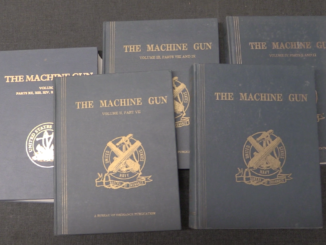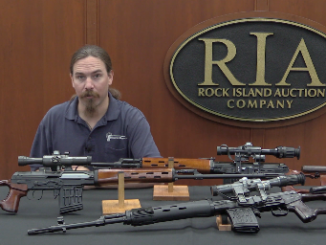https://youtu.be/Hecvt_oGvb4
The Soviet Union began to take an interest in military suppressors in the early 1930s, and experimented with things like suppressors for the DP light machine gun. Through the 1930s a variety of different designs were tested, but none were found really suitable. Everything they tested was deemed too heavy, too loud, or detrimental to accuracy. The Bramit (“Brothers Mitin”) design we are looking at today was first tested by the NKVD in June 1940, and that organization adopted it in December of 1940. Production began in Leningrad in September 1941, and expanded to three additional factories shortly thereafter.
The Bramit is specifically made for the Mosin Nagant M91/30, locking around the front sight. It is a wipe-based suppressor, with two large rubber wipes or baffles with an open chamber between them. It was designed for use specifically with subsonic ammunition, and the body of the suppressor was engraved with a conversion table to show proper rear sight settings for different ranges with that low-velocity subsonic ammunition.
Because the design used wipes, it had an expected lifespan of only about 60 rounds before the wipes were completely shot out and required replacement. However, in winter use the rubber because more brittle, and lasted only 15-20 rounds. This led to a development of a different winter composition in 1942, and eventually a better all-season type of wipe in 1943 using Lead-Lease supplies of rubber. The Bramits were used by snipers, some partisans, and both Army and NKVD scouts. Production ended in early 1944, with enough made to fully equip everyone who needed them. The total production is unclear, but 1942 alone saw 60,000 made.




Are you going to field test the reproduction?
Wonder if it could be used on the carbines w/o washers to tamp the blast?
It’s probably a lot handier on a carbine, but the subsonic ammo being a key part of the system, a bunch of unburned propellent gases left over from a shorter barrel may undermine the efficacy of such a wee little can. Sure begs trying, though.
“(…)begs trying(…)”
http://smallarms.ru/glosary?id=6
Variant of said suppressor was tested with Carbine Pattern 1938, it did not get widespread usage as its range was limited to bit above 100 m and it make more noise due to higher pressure.
“(…)lot handier(…)”
For situation where overall length must be limited, suppressed version of PPSh might be better choice, see 2nd image from top: https://www.kalashnikov.ru/besshumnyj-ppd-mif-ili-realnost/
Observe that magazine was altered to fit cartridge with longer (Spitzer) bullets
“(…)carbines w/o washers to tamp the blast?”
If you wish to have something like washers-less suppressor at Carbine pattern 1944 then consider using ВГ-44, see 3rd image from top
http://oruzhie.info/granatomety/834-vg-44-vg-45
It is grenade-launcher (another variant available for SKS), tests would be required how (if it any way) it does affect brightness.
I wonder if they were using asbestos rubber which isn’t harmed by higher tempertures
Ambulance chaser ad in 3…2…1…
Not during the Great Patriotic War and certainly not in the soviet monocity of Asbest. no need to guess what their most important product used to be.
http://www.asbestadm.ru.
to answer the original question I’d say very probabaly yes. It was a common heat resistant material at the time.
“(…)common heat resistant material at the time.”
For more data see https://comicbookplus.com/?dlid=69985
“(…)Soviet Union began to take an interest in military suppressors in the early 1930s,(…)”
First known design of suppressor is dated 1929, thus interest must exist earlier.
It was quite peculiar one for Nagant revolver and used gas entrapment principle.
See 3rd image from top https://zbroya.info/ru/blog/10328_kto-skazal-chto-revolver-ne-sovmestim-s-glushitelem/
Bullet in sabot was used, said sabot stopped inside forward cylinder, therefore lessening gas escape. Forward and rearward cylinders were rotating in unison.
“First known design of suppressor is dated 1929”
That doesn’t mean the Soviet “began to take an interest in” suppressor before 1929.
“(…)Bramit is specifically made for the Mosin Nagant M91/30(…)”
This is not true, even if you ignore prototypes. Bramit device for DP machine gun, officially designated СГ-ДП, was procured in Leningrad. It could be used in full-auto mode and worked together with gas system of host weapon, for details see 3rd image from bottom https://www.kalashnikov.ru/leningradskie-bramity/
500 examples were ordered.
My best guess is that the suppressed light machine gun would be used for ambushes. Muffling the sound signature of the machine gun may confuse anyone caught on the receiving end. I could be wrong.
It could also have been intended as a sound moderator for the DTM, the tank machine gun version of the DP. Even with the muzzle outside of the hull in the mount, the DTM shared the DP’s nasty muzzle signature, and subsonic ammunition would only slightly reduce that.
Avoiding having “one more thing” to deafen tank crewmen might have seemed a reasonable measure. And unlike the infantry LMG, the extra weight and bulk of the sound reducer would be largely irrelevant on a tank-mounted gun.
cheers
eon
“This particular” Bramit is specifically made for the Mosin Nagant M91/30
Anyone know who made the reproduction?
It looks like equipping the scouts with squash racquets would make more sense – the speed of the squash ball is potentially higher than tis subsonic ammunition, the ball mass twice as big, and the racquet lasts longer than 60 shots…
I worked at the USMC Air Ground Museum as a volunteer and was disassembling a Zis-3 divisional artillery piece. Early on I was attempting to remove the muzzle break and no matter how large a cheater bar I used the darned thin refused to move. Finally Joe Payton, the restorations curator (who’s specialty was aircraft restoration) suggested that it might have left handed thread. Sure enough, two taps with a pry bar and it came right off. Why a left handed thread? Only the whacko commie who designed the critter can answer that question.”